Search.aguea.com (Removal Instructions) - Chrome, Firefox, IE, Edge
Search.aguea.com Removal Guide
What is Search.aguea.com?
Search.aguea.com – a browser hijacker which claims to be simple, fast, and private

Search.aguea.com is a browser hijacker[1] that claims to be an excellent alternative for traditional search engines and valuable addition to user browsers. In reality, it is just another search engine that should be avoided due to several unpleasant features added to it.
You can be convinced that it is a great search engine as it offers using several modes while searching the web: safe search feature highlighted keywords and results in a new tab. However, after reading “Terms and Conditions” or “Privacy Policy”, you can find that it can easily track your searches on the Internet by recording information that you add while visiting your favorite websites.
Moreover, it's capable of redirecting to questionable sites and showing misleading ads. For this and many other reasons that we'll explain in this article, we recommend removing this browser hijacker from your device, and we'll show you how to do it.
| name | Search.aguea.com |
|---|---|
| Type | Browser hijacker, redirect virus, potentially unwanted program |
| Symptoms | Altered browser preferences (default search engine, new tab, homepage); diminished PC performance; new tabs with questionable websites open out of the blue |
| Risks | Privacy issues; redirects to malicious websites might lead to severe computer infections |
| Distribution | Fake Flash Player updates, software bundling |
| Elimination | For manual removal, use our instructions below. For an automatic one, use reliable security software |
| System health check | To ensure a stable working environment, you should check your device for errors with the time-proven FortectIntego PC repair software |
Browser hijackers always appoint a search engine of their choice. Although the results are shown from legitimate search engines like Yahoo or Bing, there is no guarantee that its search results are harmless. Redirects to malicious websites are pretty standard while dealing with such cyber threats.
Finally, we should warn you about commercial pop-up ads and in-text links that you can start seeing on your favorite websites. To prevent these problems, you need to take care of Search.aguea.com removal right after finding this hijacker on your computer.
Keep in mind that the internet is full of alternative search engines developed with one goal in mind – earning money. Therefore, even if you restrain from visiting fraudulent and suspicious domains, you might find yourself on gambling websites or other domains with disturbing content.
If you are not careful enough, you can end up with additional PUPs or even malware,[2] not only search.aguea.com virus, on your computer. Due to the redirect ability and similar issues, we highly recommend you remove it from the system.
You can remove it either manually or automatically. For the former option, feel free to use our comprehensive guides at the bottom of the article. If you can't be bothered with following instructions or don't have time for it, go for the automatic removal by downloading Malwarebytes, SpyHunter 5Combo Cleaner, or similar reliable anti-malware software.
Once you've downloaded and installed it, update its virus database, so you have the latest signatures. Then perform a full system scan. That should remove Search.aguea.com. Afterward, use the FortectIntego system diagnostics tools to take care of the overall system health.

The distribution methods of hijacker
Usually, browser hijackers tend to attach themselves to free applications, for example, PDF creators, video streaming software, etc. Since users pay little attention while installing any tool, the additional apps remain unnoticed. As a result, they reboot their computer and discover that each of their browsers is hijacked.
To prevent such a problem, make sure you opt for “Custom” or “Advanced” installation settings when you are about to install a new application. These settings will help you to see all additional applications which are trying to infiltrate your computer.
Researchers from udenvirus.dk[3] warn that not all such “optional components” are malicious. However, most of them are useless and questionable at best. Besides these steps, there are other crucial precautions, for example, updating your applications regularly, using reliable anti-spyware, and avoiding suspicious plug-ins and websites.
Remove Search.Aguea.com virus with proper security software
The fastest way to be done with its removal is to install a trustworthy anti-spyware application, update it and run a full system scan. All tools that you can use for eliminating it are given below. They will not only help you with fixing your computer after the virus infiltration but will also protect it in the future.
In addition, you can also remove Search.Aguea.com virus manually by using guidelines created by our experts. They can be applied to adware removal as well. On the final note, you should also keep away from the domains overloaded with ads that suggest scanning your system or containing links to supposedly amusing pages. You should also take care of abandoned and outdated software.
You may remove virus damage with a help of FortectIntego. SpyHunter 5Combo Cleaner and Malwarebytes are recommended to detect potentially unwanted programs and viruses with all their files and registry entries that are related to them.
Getting rid of Search.aguea.com. Follow these steps
Uninstall from Windows
Instructions for Windows 10/8 machines:
- Enter Control Panel into Windows search box and hit Enter or click on the search result.
- Under Programs, select Uninstall a program.
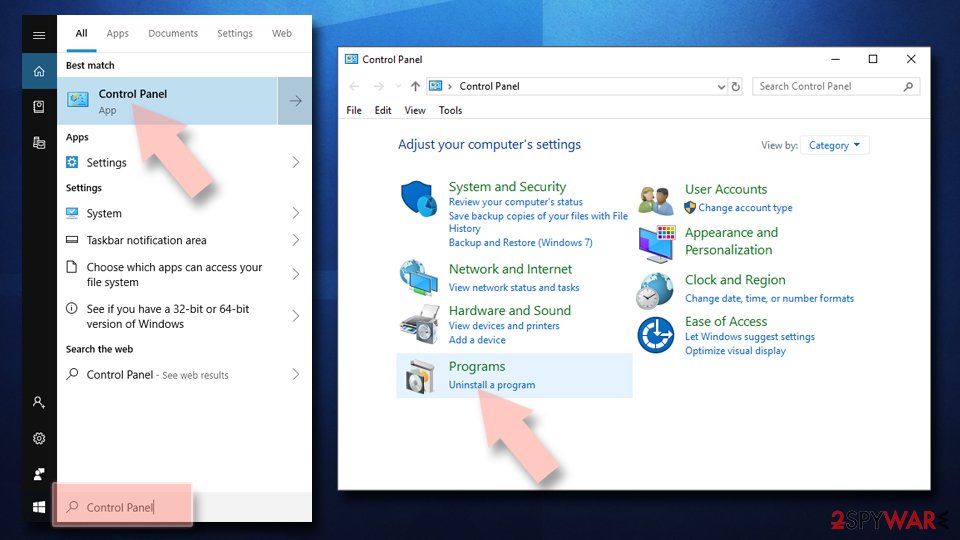
- From the list, find the entry of the suspicious program.
- Right-click on the application and select Uninstall.
- If User Account Control shows up, click Yes.
- Wait till uninstallation process is complete and click OK.
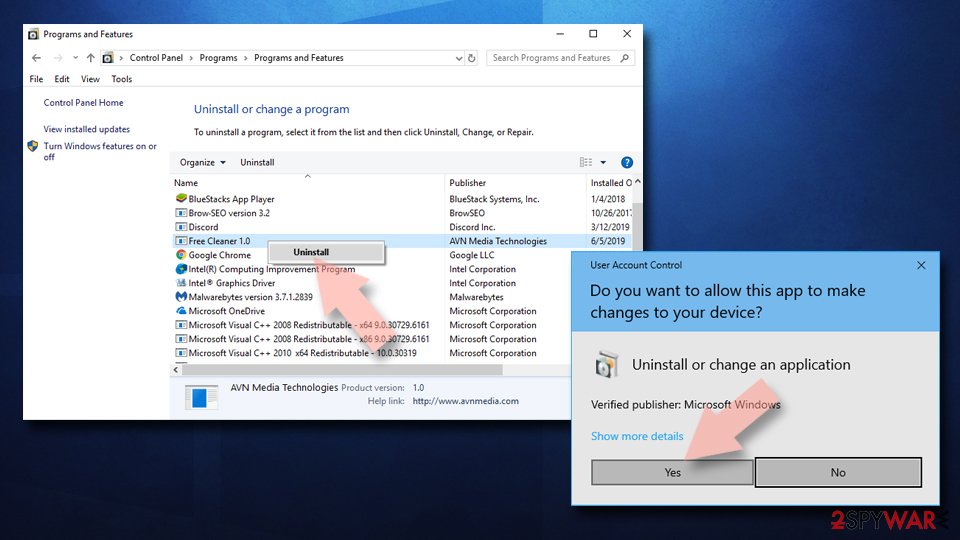
If you are Windows 7/XP user, proceed with the following instructions:
- Click on Windows Start > Control Panel located on the right pane (if you are Windows XP user, click on Add/Remove Programs).
- In Control Panel, select Programs > Uninstall a program.
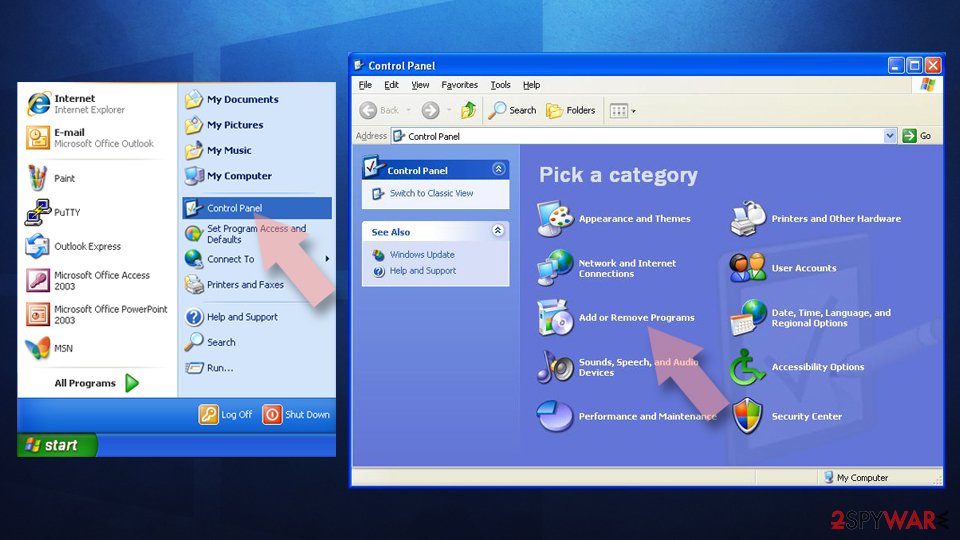
- Pick the unwanted application by clicking on it once.
- At the top, click Uninstall/Change.
- In the confirmation prompt, pick Yes.
- Click OK once the removal process is finished.
Delete from macOS
Remove items from Applications folder:
- From the menu bar, select Go > Applications.
- In the Applications folder, look for all related entries.
- Click on the app and drag it to Trash (or right-click and pick Move to Trash)
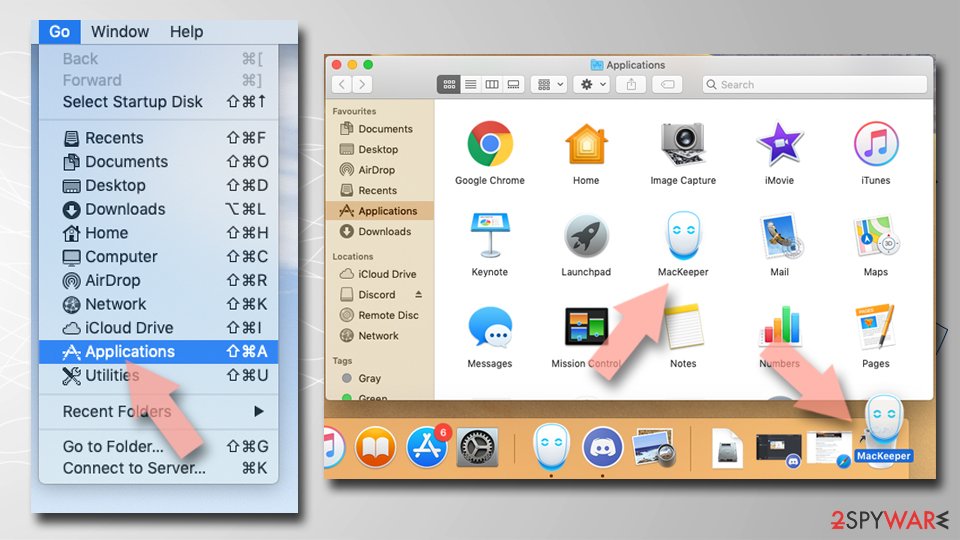
To fully remove an unwanted app, you need to access Application Support, LaunchAgents, and LaunchDaemons folders and delete relevant files:
- Select Go > Go to Folder.
- Enter /Library/Application Support and click Go or press Enter.
- In the Application Support folder, look for any dubious entries and then delete them.
- Now enter /Library/LaunchAgents and /Library/LaunchDaemons folders the same way and terminate all the related .plist files.

Remove from Microsoft Edge
After the hijack, you should reset Microsoft Edge to get back to normal browsing.
Delete unwanted extensions from MS Edge:
- Select Menu (three horizontal dots at the top-right of the browser window) and pick Extensions.
- From the list, pick the extension and click on the Gear icon.
- Click on Uninstall at the bottom.
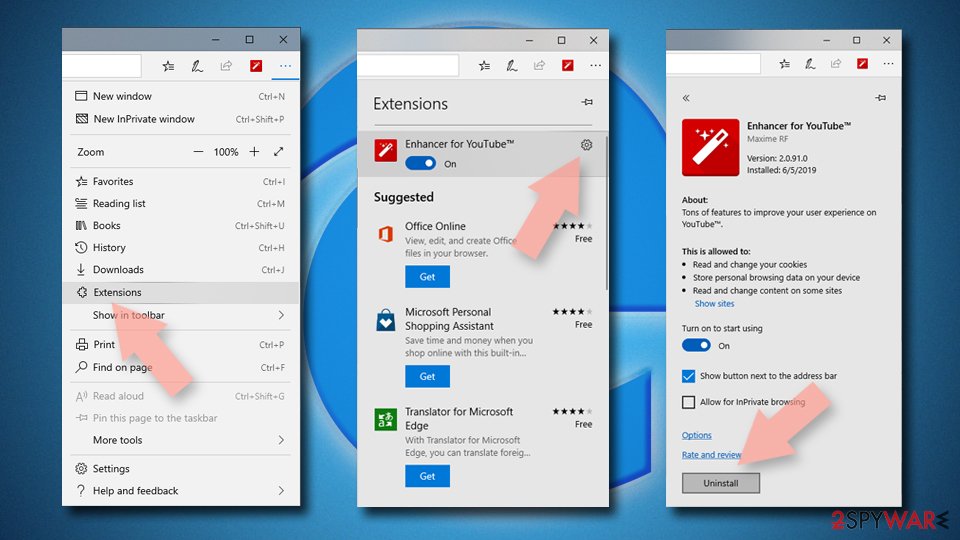
Clear cookies and other browser data:
- Click on the Menu (three horizontal dots at the top-right of the browser window) and select Privacy & security.
- Under Clear browsing data, pick Choose what to clear.
- Select everything (apart from passwords, although you might want to include Media licenses as well, if applicable) and click on Clear.
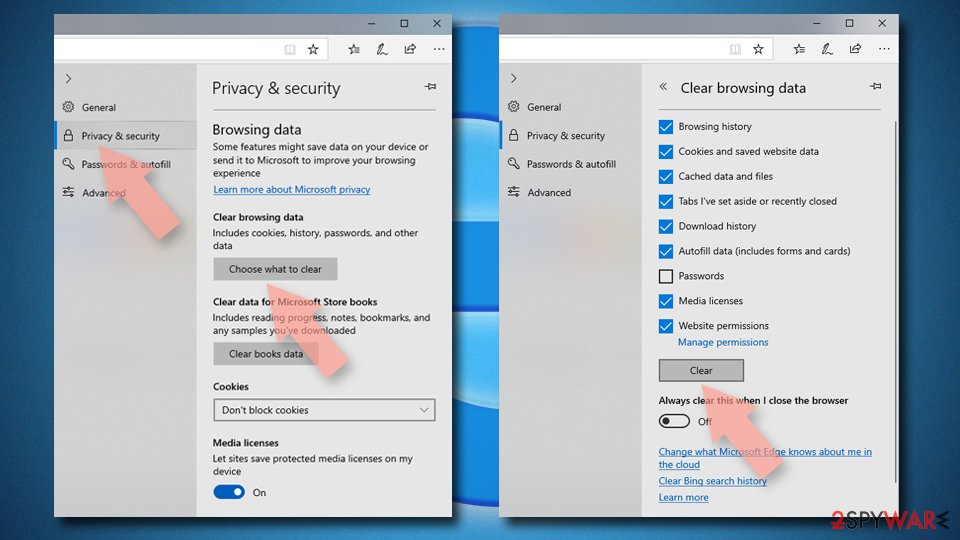
Restore new tab and homepage settings:
- Click the menu icon and choose Settings.
- Then find On startup section.
- Click Disable if you found any suspicious domain.
Reset MS Edge if the above steps did not work:
- Press on Ctrl + Shift + Esc to open Task Manager.
- Click on More details arrow at the bottom of the window.
- Select Details tab.
- Now scroll down and locate every entry with Microsoft Edge name in it. Right-click on each of them and select End Task to stop MS Edge from running.
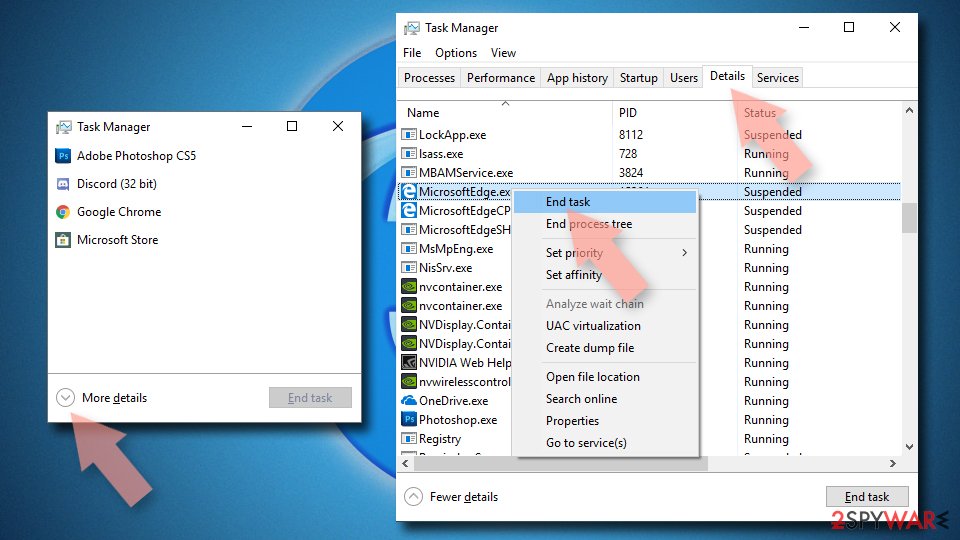
If this solution failed to help you, you need to use an advanced Edge reset method. Note that you need to backup your data before proceeding.
- Find the following folder on your computer: C:\\Users\\%username%\\AppData\\Local\\Packages\\Microsoft.MicrosoftEdge_8wekyb3d8bbwe.
- Press Ctrl + A on your keyboard to select all folders.
- Right-click on them and pick Delete
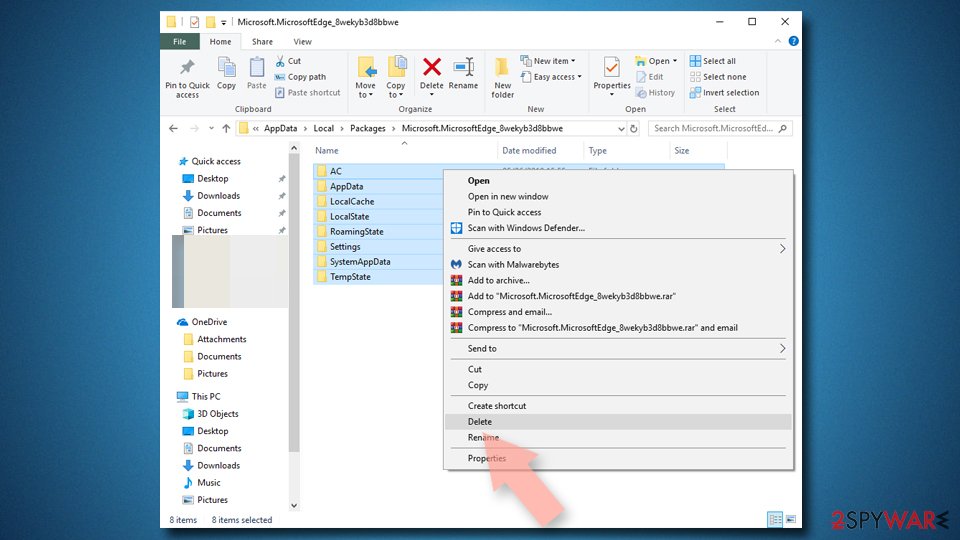
- Now right-click on the Start button and pick Windows PowerShell (Admin).
- When the new window opens, copy and paste the following command, and then press Enter:
Get-AppXPackage -AllUsers -Name Microsoft.MicrosoftEdge | Foreach {Add-AppxPackage -DisableDevelopmentMode -Register “$($_.InstallLocation)\\AppXManifest.xml” -Verbose
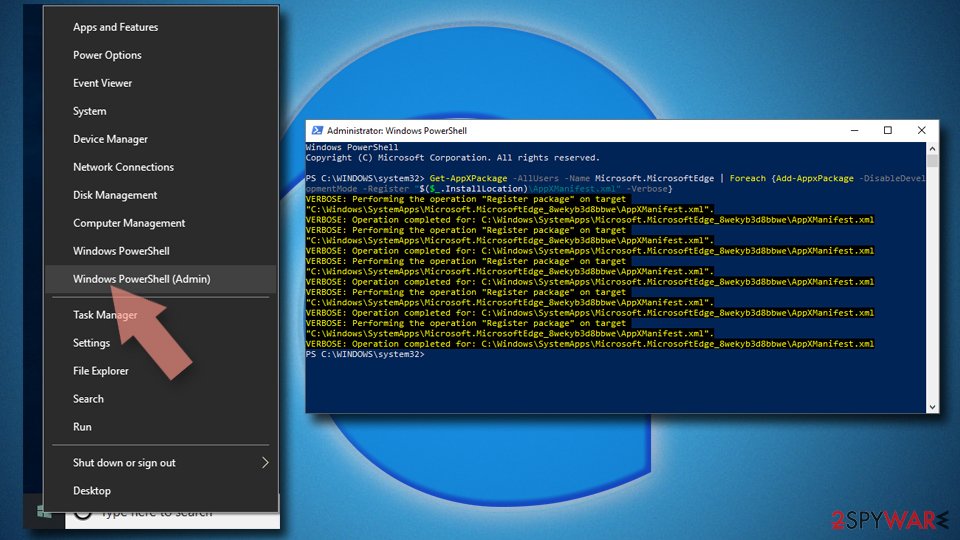
Instructions for Chromium-based Edge
Delete extensions from MS Edge (Chromium):
- Open Edge and click select Settings > Extensions.
- Delete unwanted extensions by clicking Remove.
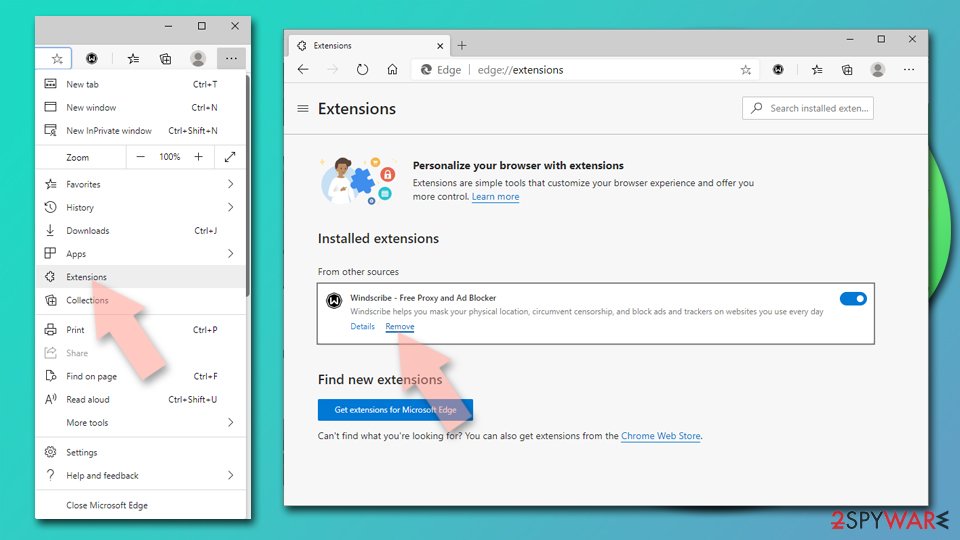
Clear cache and site data:
- Click on Menu and go to Settings.
- Select Privacy, search and services.
- Under Clear browsing data, pick Choose what to clear.
- Under Time range, pick All time.
- Select Clear now.
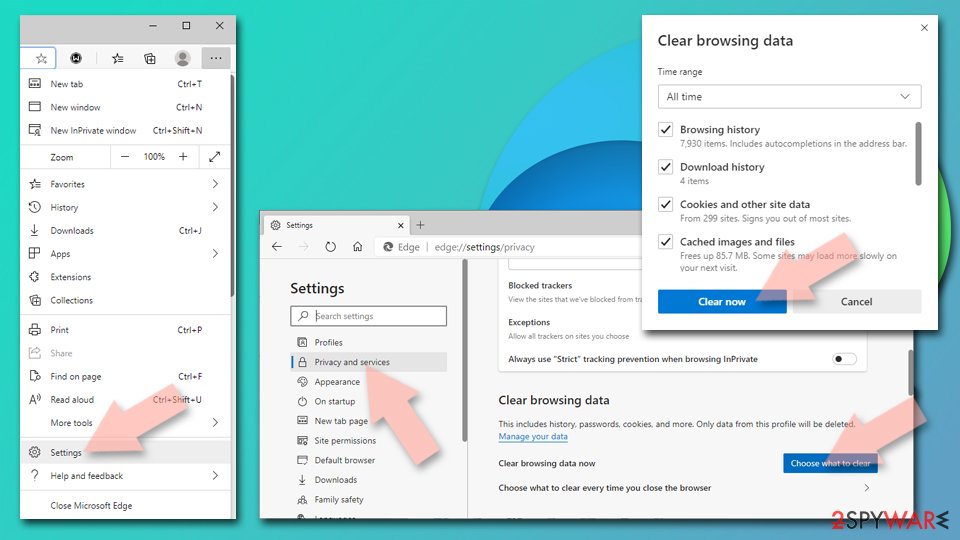
Reset Chromium-based MS Edge:
- Click on Menu and select Settings.
- On the left side, pick Reset settings.
- Select Restore settings to their default values.
- Confirm with Reset.
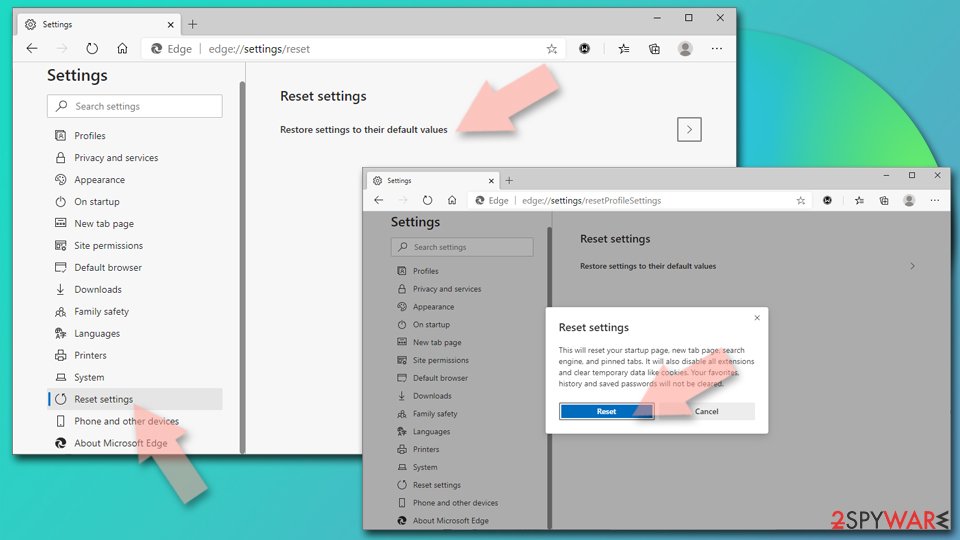
Remove from Mozilla Firefox (FF)
Uninstall suspicious Firefox extensions and reset the browser to get rid of the PUP.
Remove dangerous extensions:
- Open Mozilla Firefox browser and click on the Menu (three horizontal lines at the top-right of the window).
- Select Add-ons.
- In here, select unwanted plugin and click Remove.
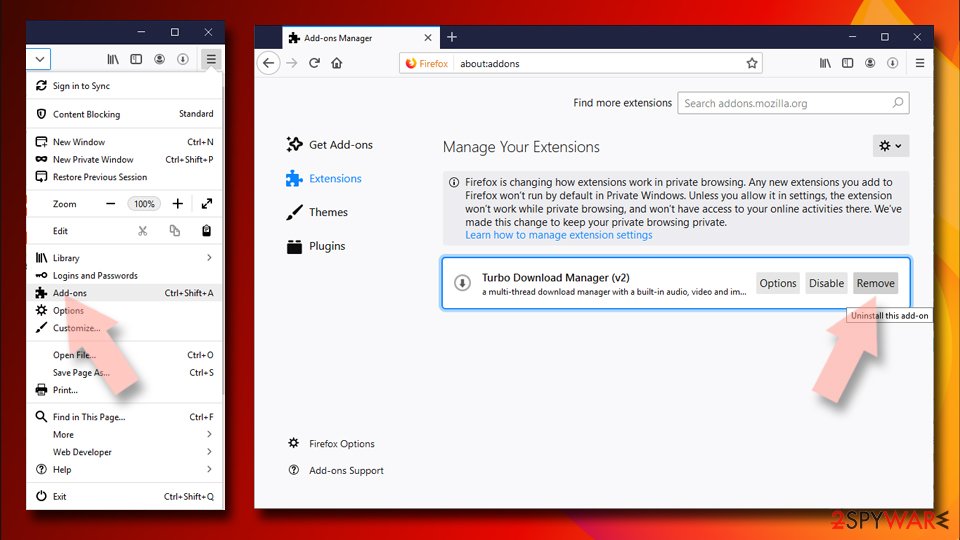
Reset the homepage:
- Click three horizontal lines at the top right corner to open the menu.
- Choose Options.
- Under Home options, enter your preferred site that will open every time you newly open the Mozilla Firefox.
Clear cookies and site data:
- Click Menu and pick Settings.
- Go to Privacy & Security section.
- Scroll down to locate Cookies and Site Data.
- Click on Clear Data…
- Select Cookies and Site Data, as well as Cached Web Content and press Clear.
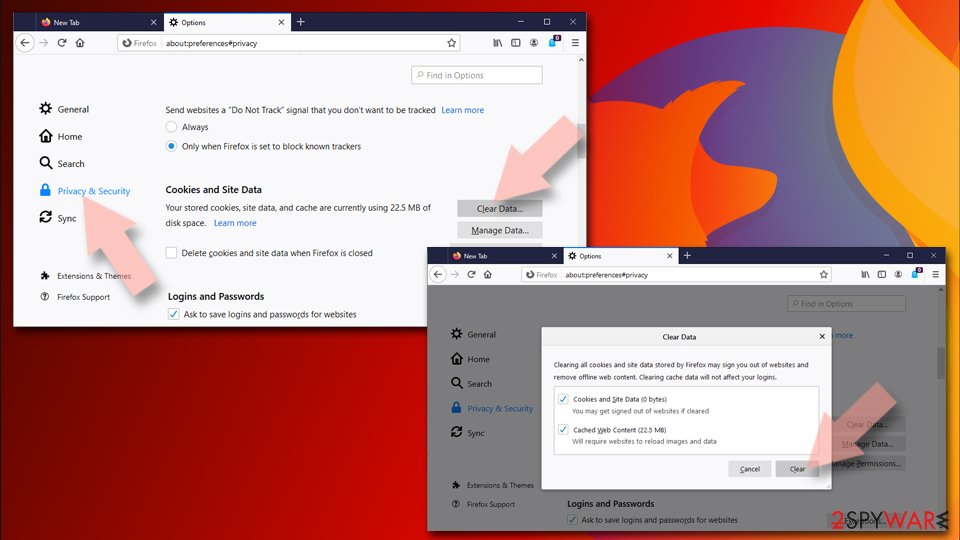
Reset Mozilla Firefox
If clearing the browser as explained above did not help, reset Mozilla Firefox:
- Open Mozilla Firefox browser and click the Menu.
- Go to Help and then choose Troubleshooting Information.
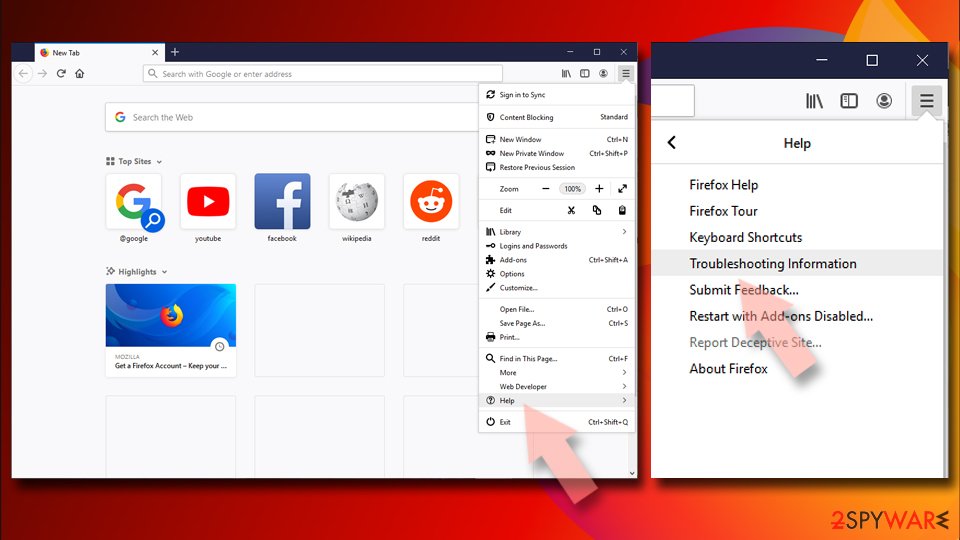
- Under Give Firefox a tune up section, click on Refresh Firefox…
- Once the pop-up shows up, confirm the action by pressing on Refresh Firefox.
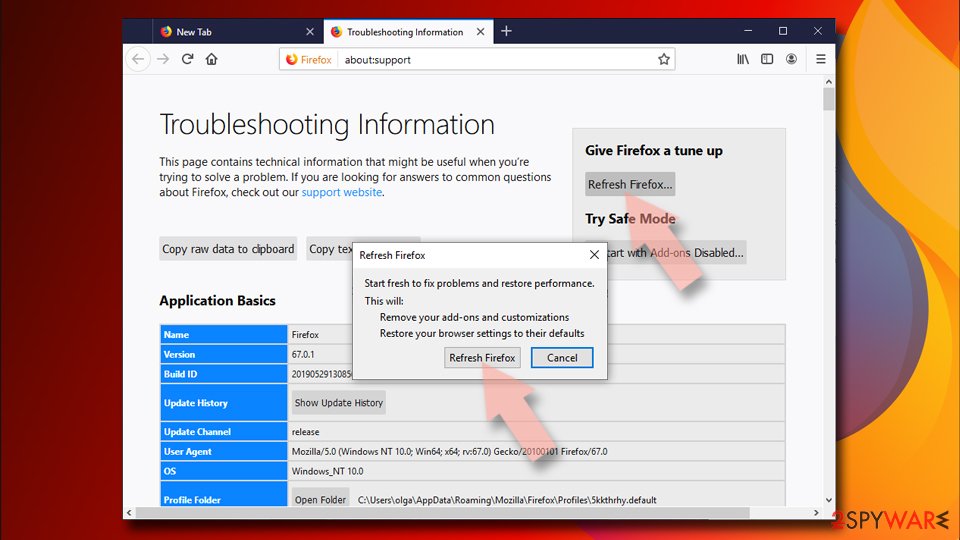
Remove from Google Chrome
Follow this guide to eliminate all hijacker-related components from Google Chrome:
Delete malicious extensions from Google Chrome:
- Open Google Chrome, click on the Menu (three vertical dots at the top-right corner) and select More tools > Extensions.
- In the newly opened window, you will see all the installed extensions. Uninstall all the suspicious plugins that might be related to the unwanted program by clicking Remove.
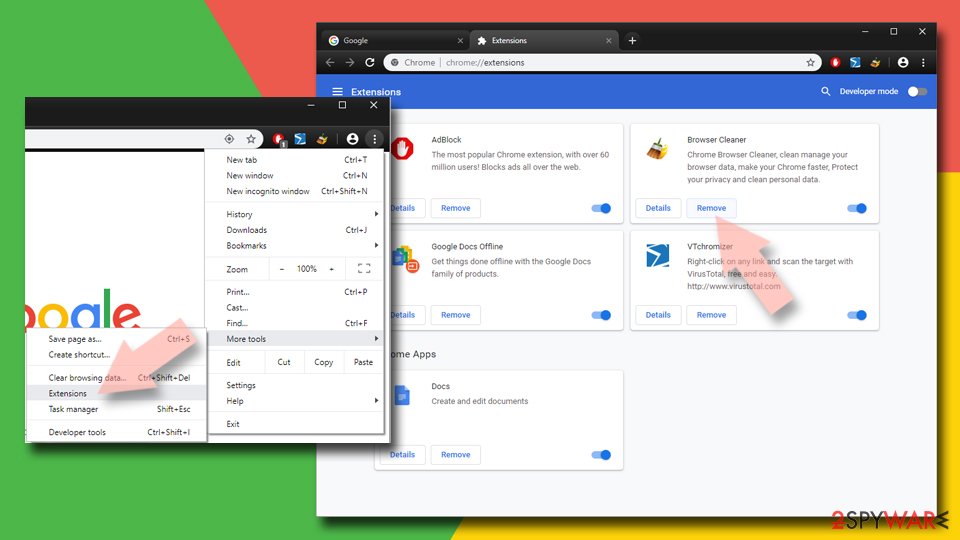
Clear cache and web data from Chrome:
- Click on Menu and pick Settings.
- Under Privacy and security, select Clear browsing data.
- Select Browsing history, Cookies and other site data, as well as Cached images and files.
- Click Clear data.
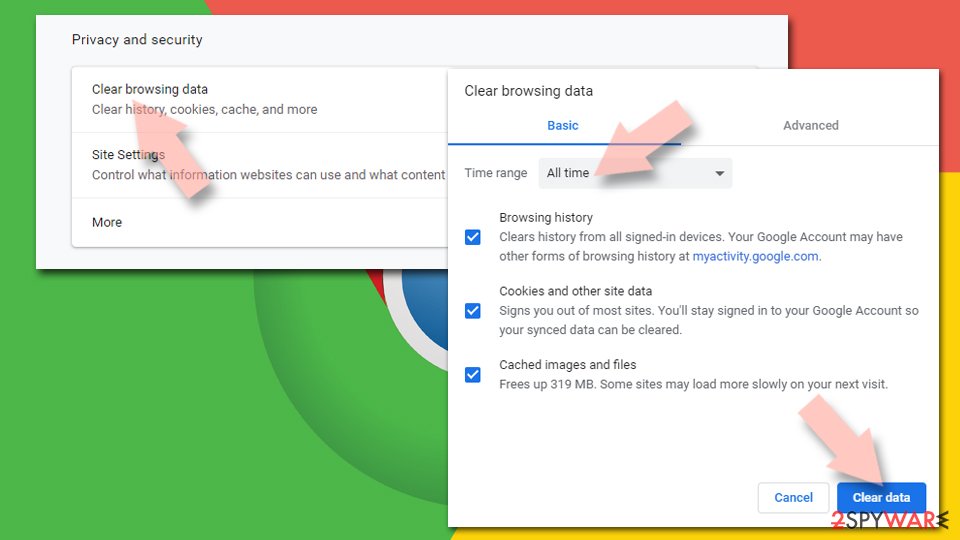
Change your homepage:
- Click menu and choose Settings.
- Look for a suspicious site in the On startup section.
- Click on Open a specific or set of pages and click on three dots to find the Remove option.
Reset Google Chrome:
If the previous methods did not help you, reset Google Chrome to eliminate all the unwanted components:
- Click on Menu and select Settings.
- In the Settings, scroll down and click Advanced.
- Scroll down and locate Reset and clean up section.
- Now click Restore settings to their original defaults.
- Confirm with Reset settings.
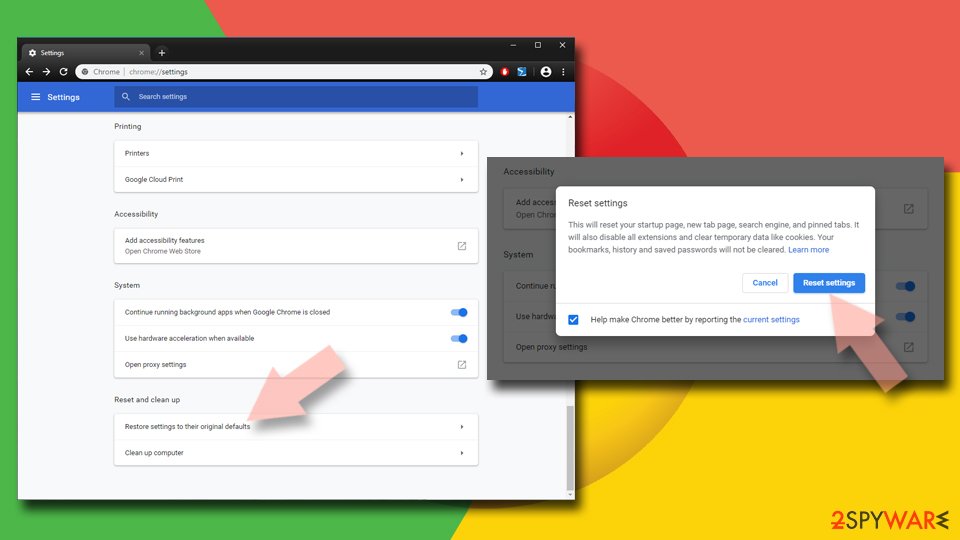
Delete from Safari
Remove unwanted extensions from Safari:
- Click Safari > Preferences…
- In the new window, pick Extensions.
- Select the unwanted extension and select Uninstall.
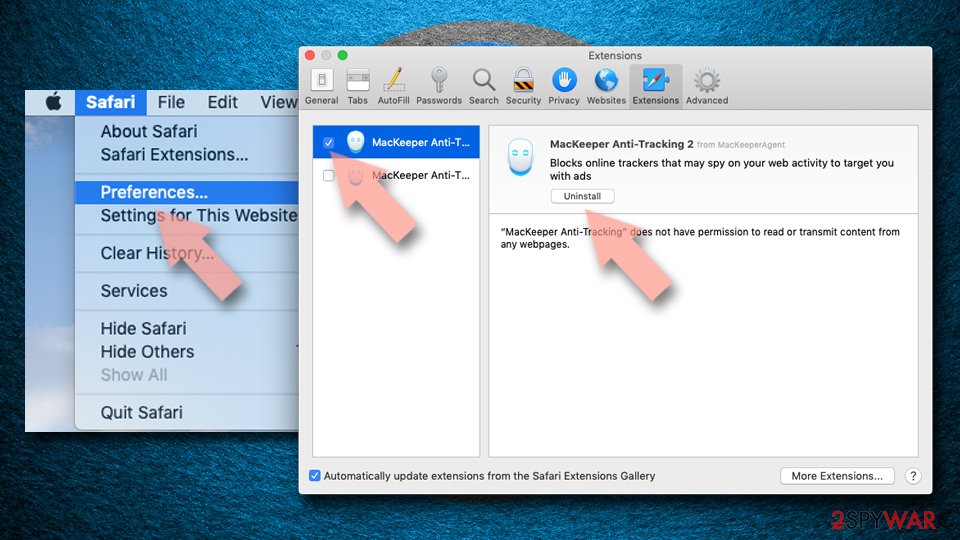
Clear cookies and other website data from Safari:
- Click Safari > Clear History…
- From the drop-down menu under Clear, pick all history.
- Confirm with Clear History.
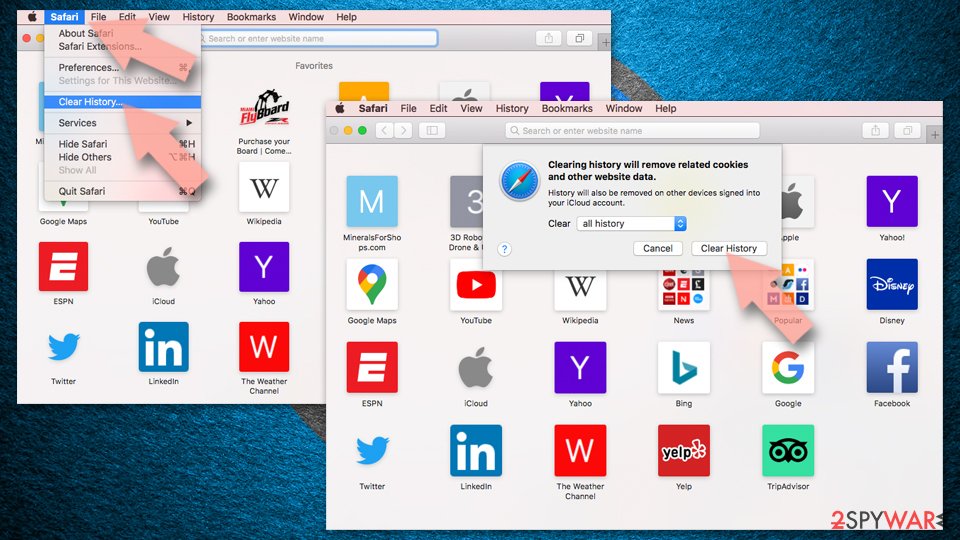
Reset Safari if the above-mentioned steps did not help you:
- Click Safari > Preferences…
- Go to Advanced tab.
- Tick the Show Develop menu in menu bar.
- From the menu bar, click Develop, and then select Empty Caches.
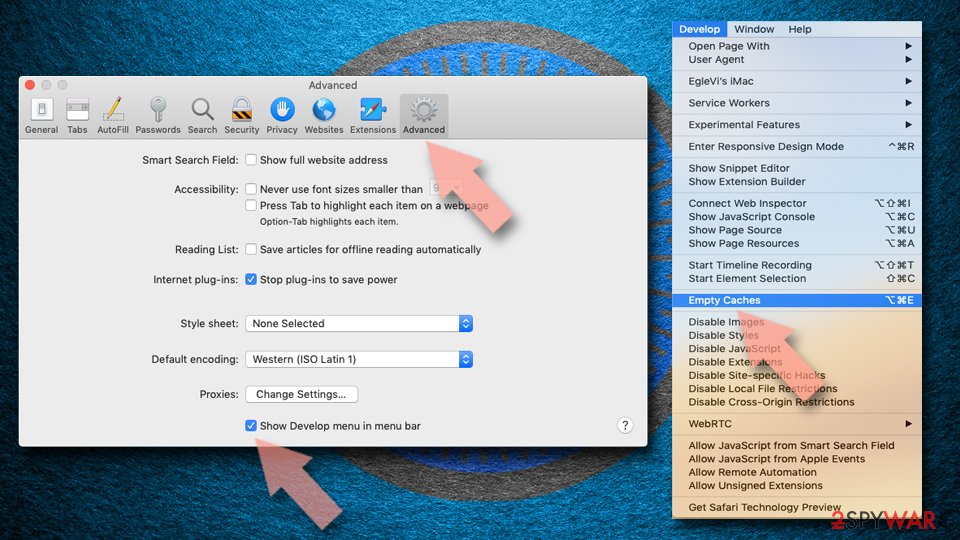
After uninstalling this potentially unwanted program (PUP) and fixing each of your web browsers, we recommend you to scan your PC system with a reputable anti-spyware. This will help you to get rid of Search.aguea.com registry traces and will also identify related parasites or possible malware infections on your computer. For that you can use our top-rated malware remover: FortectIntego, SpyHunter 5Combo Cleaner or Malwarebytes.
How to prevent from getting browser hijacker
Protect your privacy – employ a VPN
There are several ways how to make your online time more private – you can access an incognito tab. However, there is no secret that even in this mode, you are tracked for advertising purposes. There is a way to add an extra layer of protection and create a completely anonymous web browsing practice with the help of Private Internet Access VPN. This software reroutes traffic through different servers, thus leaving your IP address and geolocation in disguise. Besides, it is based on a strict no-log policy, meaning that no data will be recorded, leaked, and available for both first and third parties. The combination of a secure web browser and Private Internet Access VPN will let you browse the Internet without a feeling of being spied or targeted by criminals.
No backups? No problem. Use a data recovery tool
If you wonder how data loss can occur, you should not look any further for answers – human errors, malware attacks, hardware failures, power cuts, natural disasters, or even simple negligence. In some cases, lost files are extremely important, and many straight out panic when such an unfortunate course of events happen. Due to this, you should always ensure that you prepare proper data backups on a regular basis.
If you were caught by surprise and did not have any backups to restore your files from, not everything is lost. Data Recovery Pro is one of the leading file recovery solutions you can find on the market – it is likely to restore even lost emails or data located on an external device.
- ^ Vangie Beal. Browser hijacker. Webopedia. Online tech dictionary.
- ^ Fileless malware: Invisible threat or scaremongering hype?. Emsisoft Blog. Latest malware analysis.
- ^ Udenvirus. Udenvirus. Cyber security news.
